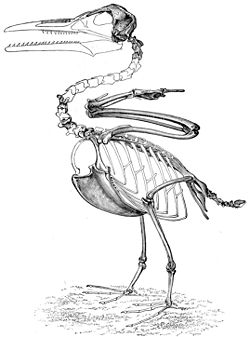- Odontognathae
-
Odontognathae 
Skeleton of Ichthyornis Scientific classification Kingdom: Animalia Phylum: Chordata Subphylum: Vertebrata Class: Aves Subclass: Neornithes Superorder: Odontognathae
Wetmore, 1930Orders Hesperornithiformes
Odontognathae is an extinct superorder of birds found widely in Kansas. The superorder was originally proposed by Alexander Wetmore, who attempted to link fossil birds with the presence of teeth, specifically of the orders Hesperornithiformes and Ichthyornithiformes. As such they would be regarded as transitional fossils between the reptil-like Archaeornithes like Archaeopteryx and modern birds. They were described by Romer as birds with essentially modern anatomy, but retaining teeth.[1]
Traits
Unlike the dinosaur-like Archaeornithes, the Odontognathae had short tails with a plowshare-shaped pygostyle and a well developed carina for flight muscle. The wings are generally without claws, though claws are found in some modern birds (the hoatzin and in kiwis). They also shared the feature of intramandibular articulation, something that is actually absent in Archaeopteryx, but found in many of its theropod relatives.[2]
The brains of the Odontognathae appear to be somewhat simpler than those of modern birds and have retained some reptile traits.[3] Ornithologist Alan Feduccia has used this, and the presence of the intramandibular articulation (a trait also found in mosasaurs and living varanid lizards) as arguments that the Odontognathae and thus the birds as a whole have not evolved from theropod dinosaurs, but non-dinosaur Thecodonts.[4] This theory is contested by most paleontologists.[5]
Classification
Classically, Odontognathiae was considered one of three superoders of Neornithes (modern birds) as opposed to Archaeornithes (the ancient birds). Today the name Neornithes is commonly used for the bird crown group, the Odontognathae being united with them the group Ornithurae.[6]
Notes
- ^ Romer, A. S. & Parsons, T. S. (1985): The Vertebrate Body. (6th ed.) Saunders, Philadelphia.
- ^ Sereno, P., Forster, Rogers and Monetta, (1993): "Primitive dinosaur skeleton from Argentina and the early evolution of Dinosauria." Nature, 361: 64-66.
- ^ Edinger, Tilly (1951). The Brains of the Odontognathae. Society for the Study of Evolution. p. 6
- ^ Feduccia, Alan; Lingham-Soliar, T; Hinchliffe, JR (November 2005). "Do feathered dinosaurs exist? Testing the hypothesis on neontological and paleontological evidence". Journal of Morphology 266 (2): 125–66. doi:10.1002/jmor.10382. ISSN 0362-2525. PMID 16217748.
- ^ Prum, Richard O. (April 2003). "Are Current Critiques Of The Theropod Origin Of Birds Science? Rebuttal To Feduccia 2002". The Auk 120 (2): 550–61. doi:10.1642/0004-8038(2003)120[0550:ACCOTT]2.0.CO;2. JSTOR 4090212.
- ^ Gauthier, Jacques, de Queiroz, Kevin (2001). "Feathered dinosaurs, flying dinosaurs, crown dinosaurs, and the name 'Aves'". in New Perspective on the Origin and Evolution of Birds: Proceedings of the International Symposium in Honor of John H. Ostrom. Yale Peabody Museum. Yale University. New Haven, Conn. USA
Categories:- Prehistoric birds
Wikimedia Foundation. 2010.
